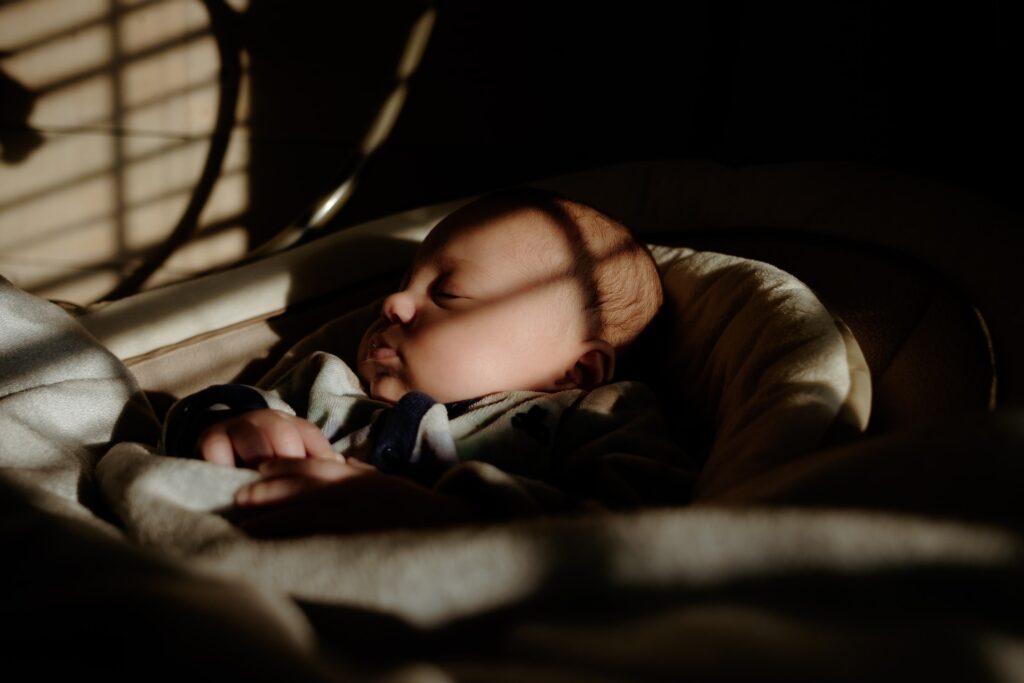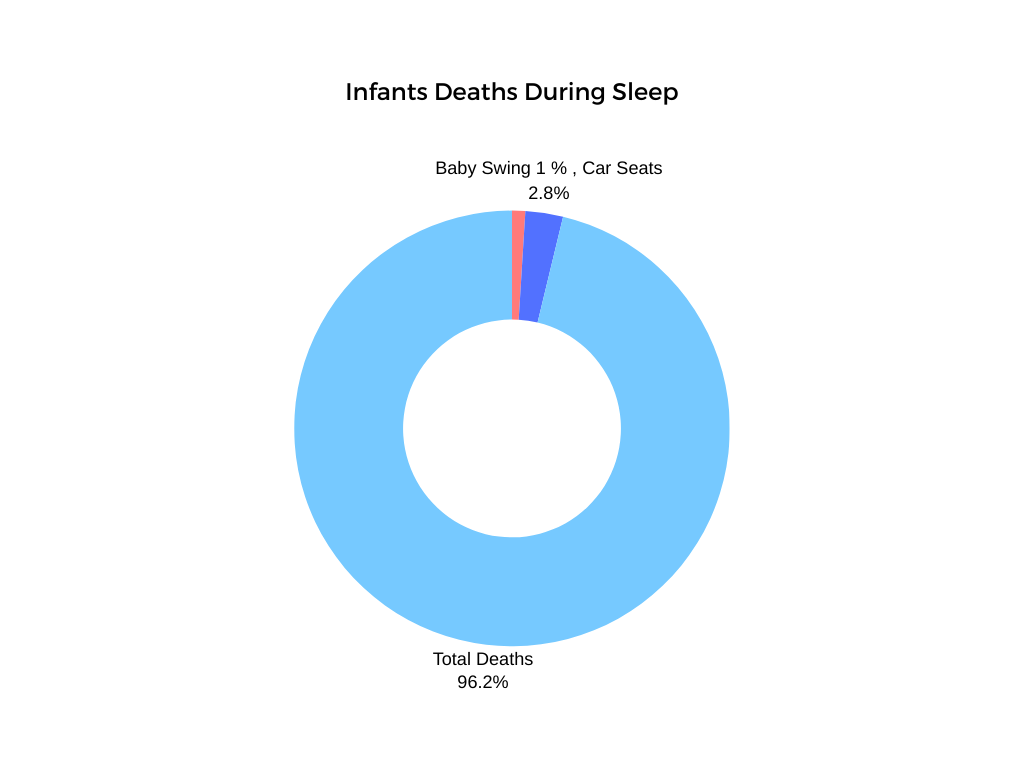Are you worried your little one spends too much time in his swing?
It is no longer a secret that babies love spending time on swings.
While swings can be an excellent tool for calming fussy infants, it’s important to find a balance and not rely on them too heavily.
Because overuse of almost every gadget can lead to harm.
In this blog post, we’ll find out
- How long can a newborn be in a swing?
- Why they even can’t use a swing for long time
- How can we break the baby’s habit of over-relying on the swing?
- And some other helpful information for new parents.
Table of Contents
How long can a newborn be in a swing?
There are two different scenarios when it comes to the overuse of swings.
In the first one, some parents use them too much because the baby stays busy enjoying the swing, giving parents much-needed free time to rest or do other home chores.
On the other side, babies get overly attached to the swing and cry to stay in the swing for an extended time. Because it gives the baby a soothing environment, and the baby doesn’t get this environment outside of the swing.
Don’t worry, we’ll talk about some solutions to break the habit of the baby’s overreliance on the swing.
But first, let’s uncover what most experts recommend about the time limit for using the swing.
What Time Limit Experts Recommend for Using the Swing
Most experts recommend that babies should not spend more than 30 minutes at a time in the swing and no more than 1 hour in the swing per day.
That means it’ll be good to use the swing in 4 different chunks of 15 minutes, or you can go with two different chunks of 30 minutes, but your baby should not use the swing more than 1 hour a day.
You should also supervise your baby and follow The American Academy of Pediatrics (AAP) safety guidelines while the baby is in the swing for safety measures.
Related: Best Baby Swings for Traveling Parents
Can baby sleep in the swing?
The American Academy of Pediatrics recommends against letting babies sleep on swings.
There are many reasons for this, but I am going to share major ones:
- Swings don’t have a firm, flat sleeping surface, unlike cribs and bassinets. Instead, babies are positioned at an angle, which can raise the chances of suffocation or positional asphyxiation.
- Secondly, swings don’t provide the same level of support and stability as a crib or bassinet. As a result, babies who fall asleep in a swing may slump forward or to the side, putting them at risk of suffocation or choking.

Why Do You Need to Take It Seriously?
If you are thinking how risky it can be to leave a baby alone in a swing while he is playing or sleeping, take a look at this research by The American Academy of Pediatrics.
This research by The American Academy of Pediatrics (AAP) shows that nearly 12000 infant deaths happened during sleep, and approximately 3% (almost 348 cases) of them occurred in sitting devices like car seats and baby swings.
In this 3% of cases, nearly 122 accidents happened in swings or bouncers.

Don’t panic, Swings are designed to be safe for babies, but a few accidents can still happen.
Millions of babies use swings safely every day and enjoy the soothing environment happily.
You need to follow all the safety guidelines I will mention below.
Related: Are Baby Swings Bad for Baby’s Development?
Why baby cannot use swing for long time
I just said that baby swings are safe for babies!
Now, you might be wondering why babies can’t use swings for long. After all, it keeps the baby entertained and gives you much-needed free time.
Little ones need plenty of time to move and exercise their bodies, which is essential for their development.
Spending too much time in a swing can limit a baby’s ability to move and slow muscle development, which can delay important milestones like crawling and walking.
In some cases, prolonged use of a swing can cause some other developmental issues for babies that you must be aware of for your baby’s safety.
What Developmental Issues Prolonged Use of Swing Can Cause
Before mentioning the developmental issues, it is crucial to understand that baby swing itself is not bad or harmful for your baby.
Its wrong use makes it bad for your baby.
You just need to use baby swings in the recommended way, and it will become a blessing for you to soothe your fussy baby.
These are some other developmental issues that the wrong use of a swing can cause:
- If the baby often stays in the swing for a long time and the baby’s head remains in the same position while using the swing, it can cause Flat Head Syndrome aka positional plagiocephaly.
- Babies are placed in a reclined position in swings to avoid slumping over, but a prolonged stay at this angle can exert pressure on their airways and cause breathing difficulties.
This risk is higher in newborns and younger infants who have developing airways. - Babies need plenty of interaction and engagement with their parents to develop strong attachments and bonds.
If a baby is left in a swing for hours, they may miss out on these essential social interactions, impacting their emotional well-being. - Spending prolonged time in a seated position can put pressure on your baby’s developing spine.
Tips to Quit Baby’s Swing Addiction
Breaking the swing’s overreliance habit requires some time and patience.
You have to adjust the baby to a new routine and stick with it. And be ready for some fussiness and tears from your baby.
These are some tips that can be helpful in quitting a baby’s overreliance on the swing:
- Gradually reduce your baby’s time in the swing by a few minutes each day. By doing this, the baby will get used to spending less time in the swing without causing too much distress.
- Create a new routine that doesn’t involve the swing. For example, you could introduce a new naptime routine that involves rocking your baby in your arms or a baby carrier instead of the swing.
- Explore some other activities that your baby loves. That can be playing with toys on the floor, playing with siblings, crawling, or cuddling in your arms for a while.
This will help him to stay busy and entertained without a swing.
If you follow these tips, your baby will soon happily play and nap without relying on the swing.
AAP recommended ways to use baby swings
It’s time to get our hands on the most important part of this post which is the safety guidelines to minimize all the risks associated with baby swings.
These are some of the vital safety guidelines recommended by AAP:
Follow the Manufacturer’s Instructions
Carefully read and follow the manufacturer’s instructions for your specific swing model to ensure proper installation and use of the swing.
And strictly follow the recommended age and weight limits for the swing, and once your baby exceeds those limits, don’t use the swing for the baby anymore.
Supervise Your Baby
As I mentioned above, it is crucial to keep an eye on your babies while they are using the swing and never leave them unattended.
You can’t compromise on it at all if your baby is still too young to hold their head up on his own.
Use the Swing on a Flat Surface
Baby swings should always be used on a flat surface and never placed on an elevated surface, such as a table or bed.
This can cause the swing to tip over and potentially harm your baby.
Secure Your Baby in the Swing:
Always use the safety harness and ensure it is properly fastened to prevent your baby from falling out of the swing.
Don’t Use the Swing as a Sleep Aid
It is not safe for babies to sleep in a swing. Once your baby sleeps, move him to a firm flat sleeping surface.
The American Academy of Pediatrics recommends babies sleep on their backs in a crib or bassinet because it provides a safer sleep environment.
Final Words
The takeaway from all of this is baby swings are absolutely safe to use until you are using them for soothing your baby for a bit of time.
Now for those who quickly scroll down to the end of this post to find the answer to “How long can a newborn be in a swing?”
Your answer is here:
The expert recommends using the swing for not more than one hour a day and not more than 30 minutes at a time.
The parents or caregiver should supervise the baby in the swing and follow all the safety guidelines recommended by The American Academy of Pediatrics (AAP) to minimize accidents.
However, improper use of a baby swing can cause harm to the baby, just like any other device.
But, it’s essential to understand that the cause of harm is the incorrect usage of the swing and not the swing itself.
FAQs
Can a Newborn Use a Swing?
Yes, a newborn can use a swing, but every swing has a minimum and maximum weight limit for the baby to use it.
Cross-check if your baby meets that limit range before buying the swing.
Use the most reclined swing angle for babies under 4 months, as their neck muscles are not yet fully developed and cannot support the weight of their heads.
If the head flops forward, it can cause suffocation.
Follow all safety guidelines recommended by The American Academy of Pediatrics (AAP) to ensure your newborn stays safe in the swing.
Do Baby Swings Cause Brain Damage?
Baby swing doesn’t cause brain damage. Swing motions aren’t intense enough to cause any brain damage.
Rather than harm, the swing’s gentle motion soothes the baby, and its movement reminds them of the womb environment, which the baby looks for in the first few months.
However, it’s essential to take all safety measures while the baby is using a swing because if the baby falls from the swing or the swing tips over, it can cause injury to the baby.
Do Swings Make Babies Sleepy?
Swings can make babies sleepy due to their rhythmic motion, which can be calming and soothing for infants.
The back-and-forth or side-to-side motion of a swing can mimic the motion of being rocked, which can help to lull babies to sleep.
However, The American Academy of Pediatrics (AAP) does not recommend letting a baby sleep in the swing.
Babies should sleep on flat, firm surfaces like Bassinets or Cribs to prevent the risk of Sudden Infant Death Syndrome (SIDS).
